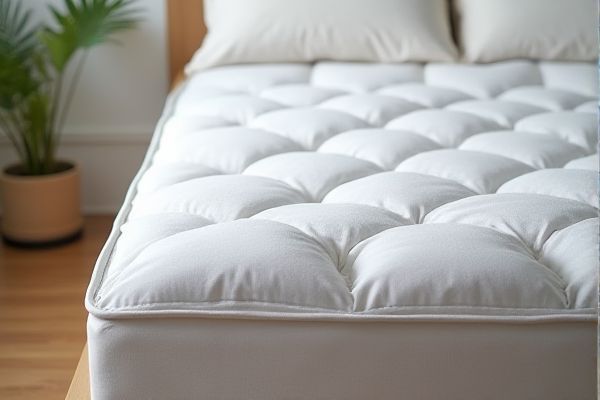
A mattress topper is a thicker, more supportive layer designed to enhance comfort and extend the life of your mattress, while a mattress pad is usually thinner, offering light cushioning and protection against spills or stains. Discover how each option can improve your sleep experience by reading the full article.
Table of Comparison
| Feature | Mattress Topper | Mattress Pad |
|---|---|---|
| Thickness | 2 to 4 inches | Less than 2 inches |
| Purpose | Enhances comfort and support | Protects mattress and adds slight cushioning |
| Materials | Memory foam, latex, feather, wool | Cotton, polyester, wool blends |
| Price Range | Medium to high ($50 - $300+) | Budget-friendly ($20 - $100) |
| Durability | Long-lasting (3-5 years) | Moderate (1-3 years) |
| Installation | Placed on top, often with straps or elastic | Fitted like a sheet or with elastic edges |
| Maintenance | Spot clean or air out; some are machine washable | Machine washable and easier to clean |
Mattress Topper vs Mattress Pad: Key Differences
Mattress toppers, typically thicker and made from memory foam, latex, or down alternative, provide significant comfort and support enhancements by altering the mattress's firmness and contouring to the body. Mattress pads are thinner, primarily designed to protect the mattress surface from spills, stains, and allergens while adding a slight cushioning effect. The key differences lie in thickness, purpose, and material, with toppers enhancing sleep quality and pads focusing on mattress protection and minor comfort improvement.
What Is a Mattress Topper?
A mattress topper is a thick, cushioned layer designed to enhance the comfort and support of an existing mattress, often made from materials such as memory foam, latex, or down feathers. Unlike mattress pads, which serve primarily as protective covers and moisture barriers, mattress toppers significantly alter the sleeping surface by adding softness or firmness according to user preference. Mattress toppers typically range from 2 to 4 inches in thickness, providing targeted pressure relief and prolonging mattress lifespan.
What Is a Mattress Pad?
A mattress pad is a thin layer of cushioning that sits directly on top of your mattress to protect it from spills, stains, and allergens while adding a slight layer of comfort. Unlike mattress toppers, mattress pads are generally less thick and provide minimal support, focusing more on surface protection and enhancing mattress longevity. You can find mattress pads made from various materials like cotton, wool, or hypoallergenic fibers to suit your specific comfort and hygiene needs.
Materials Used in Mattress Toppers and Pads
Mattress toppers are typically made from high-density memory foam, latex, or down feathers, providing added support and cushioning to improve sleep quality. Mattress pads, on the other hand, often feature quilted cotton, polyester blends, or thin foam layers designed primarily for protection and light comfort. Choosing the right material for your mattress topper or pad depends on your preference for firmness, breathability, and durability.
Comfort and Support Comparison
Mattress toppers provide enhanced comfort by adding an extra layer of cushioning and contouring support, often made from memory foam or latex to relieve pressure points and improve sleep quality. Mattress pads primarily protect the mattress surface while offering minimal additional cushioning, typically made from quilted or thin materials that provide slight softness without significant support. Choosing between the two depends on the need for increased support and comfort versus simple mattress protection.
Durability and Longevity
Mattress toppers, often made with high-density memory foam or latex, offer greater durability and can maintain their supportive structure for several years. Mattress pads are typically thinner, made from quilted fabrics or fiberfill, and may compress or wear out more quickly, usually within one to two years. Investing in a quality mattress topper ensures longer-lasting comfort and enhanced mattress protection compared to standard mattress pads.
Protection and Maintenance Features
A mattress topper offers enhanced protection by adding an extra layer of cushioning that shields the mattress from wear and extends its lifespan, while mattress pads primarily provide a basic protective barrier against spills and allergens. Mattress toppers typically feature durable, high-quality materials like memory foam or latex that resist compression and improve sleep comfort, whereas mattress pads are often made from lighter fabrics designed for easy maintenance and frequent washing. Choosing between the two depends on whether improved mattress longevity or simple protective maintenance is the priority.
Ideal Uses and Suitability
Mattress toppers provide enhanced comfort and pressure relief, making them ideal for improving the feel of a firm or aging mattress, especially for side sleepers and individuals with joint pain. Mattress pads primarily protect the mattress from stains, allergens, and wear, making them suitable for everyday use on new mattresses or in households with pets and children. Selecting between the two depends on whether the goal is to enhance comfort or preserve mattress quality.
Cost and Value Considerations
Mattress toppers generally cost more than mattress pads but offer greater durability and enhanced comfort, making them a worthwhile investment for improving sleep quality. Mattress pads are more affordable and provide basic protection and light cushioning, ideal for those on a tight budget or seeking minimal enhancement. Your choice depends on balancing initial cost against long-term value and personal comfort needs.
Which One Should You Choose?
Mattress toppers offer enhanced comfort and support by adding several inches of cushioning, ideal for improving an old mattress or customizing firmness. Mattress pads are thinner, primarily designed to protect the mattress from stains and wear while adding minimal softness. Choose a mattress topper for significant comfort improvement or a mattress pad for basic protection and slight softness.
 homyna.com
homyna.com